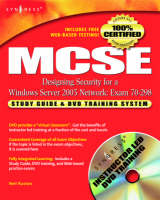
MCSE Designing Security for a Windows Server 2003 Network (Exam 70-298)
Syngress Media,U.S. (Verlag)
978-1-932266-55-9 (ISBN)
- Titel ist leider vergriffen;
keine Neuauflage - Artikel merken
MCSE Designing Security for a Microsoft Windows Server 2003 Network (Exam 70-298) Study Guide and DVD Training System is a one-of-a-kind integration of text, DVD-quality instructor led training, and Web-based exam simulation and remediation. This system gives you 100% coverage of the official Microsoft 70-298 exam objectives plus test preparation software for the edge you need to pass the exam on your first try:
Chapter 1 Designing a Secure Network Framework
Introduction
1.1 Analyzing Business Requirements for Security Design
1.1.1 Analyzing Existing Security Policies and Procedures
1.1.2 Determining Requirements for Securing Data
1.4 Analyzing Current Security Practices
1.2 Designing a Framework for Implementing Security
1.2.1 Predicting Threats to Your Network
1.1.3 Analyzing Security Requirements for Different
12.2 Responding to Security Incidents
1.2.4 Recovering Network Services After an Attack
1.3 Analyzing Technical Constraints when Designing Security
1.3.2 Identifying Technology Limitations
1.3.3 Analyzing Interoperability Constraints
Chapter 2 Securing Servers Based on Function
Introduction
3.7.1 Defining a Baseline Security Template
3.7 Design Security for Servers that Have Specific Roles
3.7.2 Modifying Baseline Security Templates According to Role
Chapter 3 Designing a Secure Public Key
Introduction
2.1 Designing a Public Key Infrastructure
2.1.1 Designing a Certification Authority Implementation
2.2 Designing a Logical Authentication Strategy
2.1.4 Designing Security for CA Servers
2.2.2 Designing Certificate Distribution
2.1.2 Designing Enrollment and Distribution
2.1.2 Approving Certificates by CA Administrators
2.1.3 Revoking Certificates by CA Administrators
2.1.3 Establishing Renewal and Auditing
Chapter 4 Securing the Network Management
Introduction
2.3 Securing the Network Management Process
2.3.1 Managing the Risks of Network Administration
2.3.2 Securing Common Administrative Tools
2.3.3 Designing Security for Emergency Management
2.4 Designing a Security Update Infrastructure
2.4.1 Designing a Software Update Service Infrastructure
2.4.2 Using Group Policy to Deploy Software Updates
2.4.3 Design a Strategy for Identifying Computers
2.2.2 Designing Trust Relationships Between Domains and Forests
2.2.3 Designing Security for Interoperability
Chapter 5 Securing Network Services and Protocols
Introduction
3.1 Designing Network Infrastructure Security
3.1.3 Designing IPSec Policies
3.1.2 Designing IP Filtering
3.1.1 Configuring a Firewall Configuration
3.1.5 Designing Security for Data Transmission
1.2.3 Using Segmented Networks
3.2 Design Security for Wireless Networks
3.2.1 Designing WLAN Network Infrastructure
3.2.2 Designing Authentication for Wireless Networks
Chapter 6 Securing Internet Information Services
Introduction
3.3 Designing User Authentication for IIS
3.3.1 Designing Certificate Authentication
3.3.2 Designing Windows Logon Authentication
3.3.3 Designing RADIUS Authentication
3.4 Designing Security for IIS
3.4.1 Securing IIS Installations
3.4.2 Designing a Monitoring Strategy for IIS
3.4.3 Creating a Monitoring Baseline
3.4.4 Design a Content Management Strategy for Updating
Chapter 7 Securing VPN and Extranet
Communications
Introduction
3.5 Designing Security for Communication Between Networks
3.5.1 Using Windows Server as a Router
3.5.3 Designing Demand Dial Routing between
3.5.2 Designing VPN Connectivity
3.6/3.6.1 Designing an Extranet Infrastructure
3.6.2 Cross-Certification of Certificate Services
Chapter 8 Securing Active Directory
Introduction
4.1 Designing an Access Control Strategy for Directory Services
2.2.4 Establishing Account Security Policies
2.2.4 Establishing Password Security
4.1.2 Analyzing Auditing Data
4.1.1 Creating a Delegation Strategy
4.1.3 Designing the Appropriate Group Strategy for Accessing Resources
4.1.4 Designing a Permission Structure for Data
Chapter 9 Securing Network Resources
Introduction
4.2 Designing an Access Control Strategy for Files and Folders
4.2.4/4.3.2 Analyzing Auditing Requirements
4.3 Design an Access Control Strategy for the Registry
4.3.1 Design a Permission Structure for Registry Objects
4.2.1 Creating a Strategy for the Encryption and Decryption of Files and Folders
4.2.3 Designing Security for a Backup and Recovery Strategy
Chapter 10 Securing Network Clients
Introduction
5.3 Securing Client Computers
5.3.1 Hardening Client Operating Systems
5.3.2 Restricting User Access to Operating System Features
5.1 Designing a Client Authentication Strategy
5.1.1/5.1.2 Analyzing Authentication Requirements
5.2 Designing a Secure Remote Access Plan
5.2.1 Designing Remote Access Policies
5.2.2 Providing Access to Internal Network Resources
5.2.3 Using Internet Authentication Service
Self Test
Self Test Quick Answer Key
Self Test Appendix
Index
| Erscheint lt. Verlag | 3.3.2004 |
|---|---|
| Verlagsort | Rockland, MA |
| Sprache | englisch |
| Maße | 178 x 229 mm |
| Gewicht | 1310 g |
| Themenwelt | Informatik ► Betriebssysteme / Server ► Windows |
| Informatik ► Betriebssysteme / Server ► Windows Server | |
| Informatik ► Netzwerke ► Sicherheit / Firewall | |
| ISBN-10 | 1-932266-55-0 / 1932266550 |
| ISBN-13 | 978-1-932266-55-9 / 9781932266559 |
| Zustand | Neuware |
| Informationen gemäß Produktsicherheitsverordnung (GPSR) | |
| Haben Sie eine Frage zum Produkt? |
aus dem Bereich


